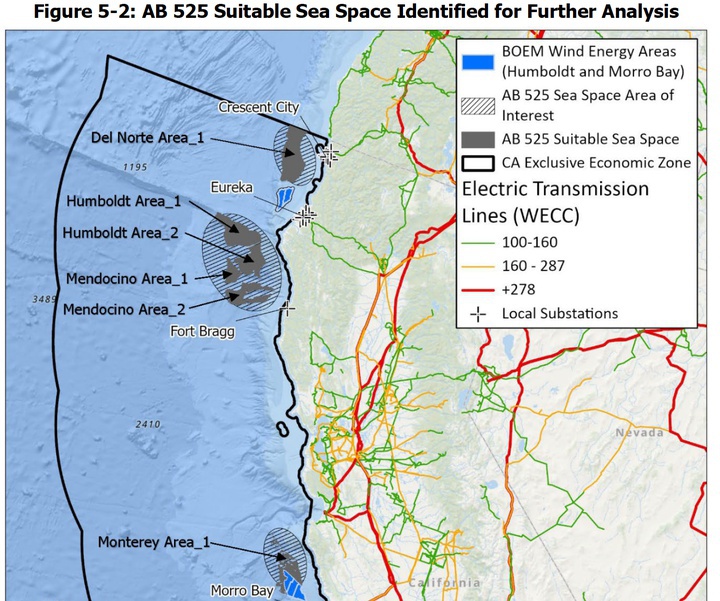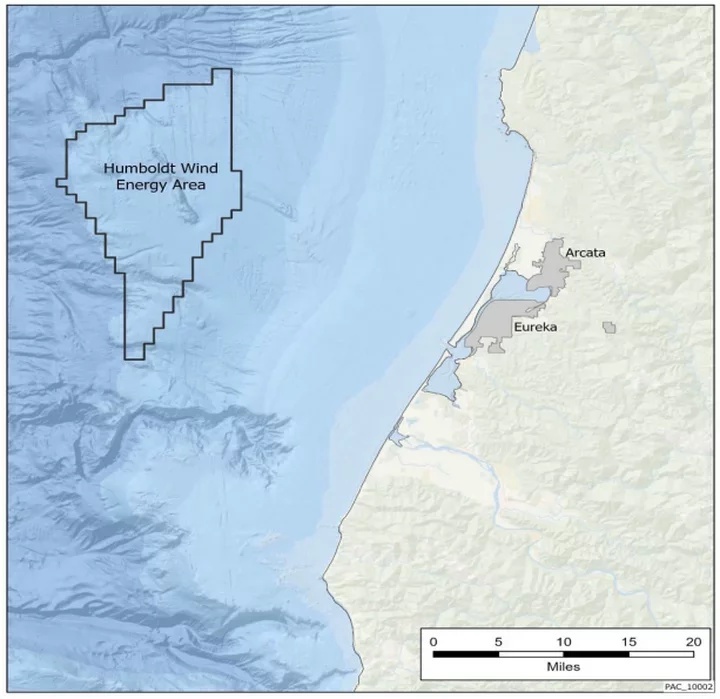Jessica Cejnar Andrews / Monday, March 4, 2024 @ 4:11 p.m.
Finding Del Norte's Place In The Offshore Wind Energy Conversation

The California Energy Commission identified Del Norte County as one of six sites that has the potential to host floating offshore wind energy platforms. | Map courtesy of the California Energy Commission
The communities that organize and engage with local, federal and state governments and developers early will be the ones that benefit, Alec Dompka told a gathering of more than 100 Del Norters on Saturday.
The U.C. Cooperative Extension’s economic development advisor for Del Norte, Humboldt and Trinity counties was a panelist in a discussion focusing on offshore wind energy generation on the North Coast.
The discussion brought Dompka and his colleague, U.C. Cooperative Extension Professor Keith Taylor, to the table with other experts, including a fisheries manager from one of the leaseholders off Humboldt Bay and a representative from the Bureau of Ocean Energy Management.
Taylor and Dompka urged community members to make the potential for floating wind farms sprouting up off of Del Norte County work for them.
“You have to fight for every dollar and benefit you’re going to get,” Dompka said. “They’re not just going to be handed to us.”
However, it’s not clear yet who’s going to do that fighting. Jonnel Covault organized the panel discussion with a group of residents calling themselves the Resilient Energy Committee. She pointed out that while many are opposed to offshore wind energy, Del Norte isn’t in a position to pass on millions of dollars in community benefits.
But, Covault said, the Resilient Energy Committee likely won’t be Del Norters’ first choice to negotiate those community benefits. Saturday’s panel discussion drew four out of five county supervisors, including two that pushed for an offshore wind exclusion clause in the Tri-Agency Economic Development Authority’s joint powers agreement. Covault said she’s thinks the Board of Supervisors will re-think its stance on the Tri-Agency’s involvement in those offshore wind energy discussions.
“I can almost guarantee you they’re going to change their mind,” she told the Wild Rivers Outpost. “They’re going to want to be involved in this.”
'
Saturday’s panel discussion came about a month after the Board of Supervisors — minus District 2 representative Valerie Starkey — approved the joint powers agreement that restricted the Tri-Agency from supporting or pursuing “activities involving the offshore generation of wind energy.”
The discussion also comes after the Crescent City Council and the Crescent City Harbor District Board of Commissioners — the two other Tri-Agency members — voted on a joint powers agreement sans the offshore wind energy exclusion clause.
On Monday, District 3 Supervisor Chris Howard, one of the county’s two representatives on the Tri-Agency board, confirmed that three of his colleagues were at Saturday’s discussion. While there’s plenty to keep the JPA busy for the next two decades, he said, it’s still the most logical entity to negotiate for community benefits when it comes to offshore wind power.
“We have to be at the table,” Howard told the Outpost. “I think every presenter basically stated that during the two-hour discussion and my hope is that our fellow board members, whatever side of the table they are on… will at least allow the county to participate in these conversations if just merely for the fact of understanding what it means to have a site located off our coast.”
In December 2022 two companies prevailed in a Bureau of Ocean Energy Management lease auction within the 207 square-mile Humboldt Bay Wind Energy Area — Vineyard Offshore and RWE.
On Saturday, Rob Holmlund, the Humboldt Bay Recreation and Conservation District’s director of development, said the wind turbines are on platforms that are about 350 by 450 feet each, which is larger than a Crescent City block. Their blades are about 300 feet long, he said, and at 20-30 miles offshore “you’ll barely be able to see them on the clearest of days.”
“You cannot manufacture the blades in Redding and put them on a truck and bring them to the coast,” he said. “They’re just too big to move by land — you can’t move them by train and you can’t move them by truck. So all of this equipment has to be manufactured in ports and then you take all of those parts, put them on ships and ship them to one single port [where] they put them all together.”

The future site of two floating offshore wind farms near Humboldt Bay. | Map: BOEM
In January, the Humboldt Bay Recreation and Conservation District was awarded about $450 million in state and federal grant dollars to build a terminal that will allow the blades, towers, nacelles, floating foundations and other parts to be assembled before they’re towed out to sea, Holmlund said.
It was in 2022 that Beth Burks introduced the Humboldt County Association of Governments board to the Offshore Wind Community Benefits Network. The Offshore Wind Community Benefits Network was created by the Redwood Region Climate and Community Resilience Hub, or Redwood COREHub, which is associated with the Humboldt Area Foundation.
Burks, HCOAG’s executive director, and Kerry Venegas, executive director for Changing Tides Community Services, sat down with the Wild Rivers Outpost on Feb. 5 — days after the Del Norte County Board of Supervisors voted to exclude the Tri-Agency from discussing offshore wind energy generation locally.
Noting that HCOAG is the regional transportation planning agency for Humboldt County that includes all seven municipalities plus county government, Burks said she felt it was important to keep her board informed about the community benefits process and offshore wind proliferation in the community.
Venegas, whose organization helps families access child care and provide developmental, mental health and behavioral health support, said Changing Tides is involved because parents will need that support if they want to take advantage of the jobs offshore wind production is expected to provide.
Though Humboldt County is much further along in the process than Del Norte, the discussion over how to make sure communities are protected continues. Venegas noted that decisions will be made that are "beyond our shores and beyond our county government and beyond our communities."
She said that since the offshore wind projects off of Humboldt County are expected to have a production life of about 30 years, it's going to impact kids who aren't even born yet.
“A lot of folks have mixed feelings. There are still a lot of folks who are very skeptical about the promise of wind development versus the potential drawbacks,” she said. “The community has to have a voice because at the end of the day they’re the ones who will be living with everything.”
If offshore wind energy isn’t the economic development boon people hope for and the jobs it provides go away, Changing Tides will be helping to pick up the pieces, Venegas said.
Negotiating those community benefits shouldn’t fall on one agency — it shouldn’t be an “either-or” situation, Venegas said.
“We can support and strengthen the economic development plans for our region and our county and our communities while simultaneously asking that they really pay attention to some of the things that never get paid attention to,” she said, adding that given the number of jobs offshore wind in Humboldt promises to provide, the need for child care and schools will be huge.
The Community Benefits Network has brought in a variety of agencies and organizations including tribal organizations and more service-driven organizations, Venegas said. It allows communities on the Samoa Peninsula who will be heavily impacted by the Humboldt Bay Recreation and Conservation District’s terminal to tell the leaseholders what they value and how they can be a good ally, she said.
Meanwhile, Del Norte County is one of six areas BOEM is investigating the California Energy Commission states has the potential to host floating offshore wind energy turbines, according to Harbor Commissioner Wes White, who was a panelist at Saturday’s discussion. White said he’s been researching and following the offshore wind energy industry for about nine years, which includes attending conferences and seminars.
Though Del Norte County has a “minimum of about a decade” before any offshore wind energy production happens, according to White, Dompka said the need for construction jobs could be felt in Del Norte County as soon as 2030 with another uptick in 2040.
Del Norte County should start engaging in those community benefit discussions now, Dompka said. A construction workforce includes heavy machinery and crane operators as well as welders. During the operations and maintenance phases, welders, machinists, vessel and machine mechanics and marine operators would likely be needed.
However, there’s a disparity between the education requirement for those jobs and Del Norte residents’ educational attainment, Dompka said.
“Sixty-two percent of Del Norte County has a high school diploma or less. Most of these jobs are going to require a two-year technical degree or, at the very least, a union apprenticeship up through journeyman,” Dompka said. “As we’re designing our workforce programs, as we’re thinking about partnering with workforce programs down in Humboldt, as we’re thinking about telling the developers what we want funded for our workforce, we have to think [about] how long is it going to take for us to get our workforce up and what skills do we want to equip our workforce with.”
Taylor, Dompka’s colleague, urged Del Norters to reach out to the Pacific Power, the Redwood Coast Energy Authority and the Coos Curry Electric Co-op to discuss the steps they’re taking to ensure their communities are getting access to jobs and are ensuring other industries, primarily commercial fishing, are being protected.
“Just get organized and get around this and you can make this wind energy project work for Del Norte County,” he said.
Despite opposition from his colleagues, Howard said the Board of Supervisors isn’t at an impasse yet over offshore wind energy development. He anticipates his colleagues voting on the revised Tri-Agency joint powers agreement this month.
Bringing up remarks Starkey made at a Jan. 26 Del Norte Association of Realtors candidate forum — that she would have urged the Tri-Agency to educate the community about offshore wind — Howard said that could change the Board’s stance.
Howard praised Covault and the Resilient Energy Committee for hosting an event that included such a diverse panel of speakers.
When asked if groups like the Resiliency Energy Committee could be part of any community benefit negotiations the Tri-Agency would try to kick start with potential developers, Howard said “absolutely 100 percent.”
“We need a very diverse group of folks at the table because everybody needs to have buy-in into the process,” he said. “I think this group had enough questions to take matters into their own hands. But you really need your elected representatives to help lead the charge in whatever the community determines is our best course of action.”
CLICK TO MANAGE